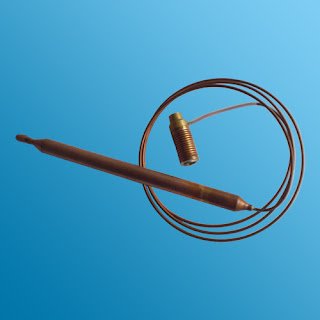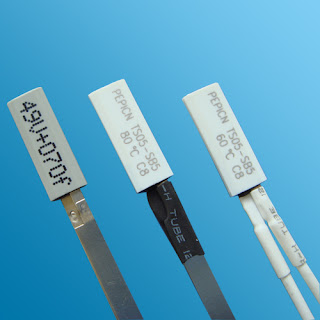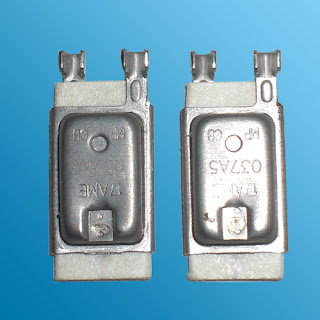Thermal switch is a temperature control device. It has many models and classifications, which sometimes make engineers confused. As an expert of making thermal swith, we'd like to share our own understanding with people who are interested in this issue.
1.
Bimetal thermal switch: there is a bimetal strip
or disc inside of the switch which composed by two kinds of metals. The two metals have different
heat expansion rates. When temperature changes, the two metal would expand. Because of the expansion rate is different, the strip would bend to the side with smaller expansion, which would finally drive the bimetal jump and disconnect or connect the circuit.
 |
| Button type bimetal thermal switch TS01 serial |
2. Capillary thermal switch: Also called capillary thermostat. It is
very easy to recognize because it has a long capillary attached to the body. Inside
of the capillary, some liquid is filled. According to the different temperature setting, the liquid can be hot medium or cold medium. Some of capillary thermal switches can be used to electric
appliances, like electrical stove, oven, refrigerator, AC etc. And some of
them would be used to gas appliances, like gas stove, gas oven,
gas water heater etc. For different applications, the construction of thermal switch would also be different.
 |
| Capillary thermal switch WKF |
3. Snap action thermal switch: it is for
bimetallic thermal switch. The bimetal inside can action very quickly and
cut the circuit off. It does not close immediately, but a time delay. After the temperature decreased to a certain value, it close the circuit again. This
thermal switch can be used for temperature protection.
 |
| Snap action thermal switch TS05 for battery pack |
4. Creep action thermal switch: it is a type of bimetal thermal switch also. It can open the circuit and close it in a short
time. The temperature differential between OFF and ON is very small. It has
good performance for temperature balance, but can
not be used for thermal protection.
 |
| Creep action thermal switch 17AME-H |
5. Auto reset thermal switch: it means that the
thermal switch can reset automatically and no manual reset button needed.
 |
| Auto reset thermal switch for automotive |
6. Manual reset thermal switch: it means that
the thermal switch can not turn ON after it turns OFF. A manual reset button or power
disconnection design would be necessary.
 |
| Manual reset thermal switch 17AME+PTC |
7. Temperature sensing thermal switch: the main
factor that influences the thermal switch OFF and ON is temperature. Current might
have some influences, but not the most important issue.
 |
| Temperature sensing thermal switch 17AME |
8. Current sensing thermal switch: the main
factor that affects the thermal switch OFF and ON is current. It is normally
used for over current protection purpose. The temperature also can make the
thermal switch turn OFF, but normally current sensing actions earlier than temperature.
 |
| Current sensing thermal switch 3MPE/6APE serial |
9. Fixed temperature thermal switch: The temperature is fixed after it
was released to customers. The end user cannot change the temperature setting.
 |
| Fixed temperature thermal switch KW serial |
10. Adjustable thermal switch: the temperature
setting is changeable and the end user can change the temperature by rotating
the knob.
 |
| Adjustable thermal switch KST serial |










